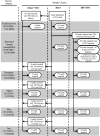Influence of therapeutic ceftiofur treatments of feedlot cattle on fecal and hide prevalences of commensal Escherichia coli resistant to expanded-spectrum cephalosporins, and molecular characterization of resistant isolates
- PMID: 23354706
- PMCID: PMC3623230
- DOI: 10.1128/AEM.03592-12
Influence of therapeutic ceftiofur treatments of feedlot cattle on fecal and hide prevalences of commensal Escherichia coli resistant to expanded-spectrum cephalosporins, and molecular characterization of resistant isolates
Abstract
In the United States, the blaCMY-2 gene contained within incompatibility type A/C (IncA/C) plasmids is frequently identified in extended-spectrum-cephalosporin-resistant (ESC(r)) Escherichia coli strains from both human and cattle sources. Concerns have been raised that therapeutic use of ceftiofur in cattle may increase the prevalence of ESC(r) E. coli. We report that herd ESC(r) E. coli fecal and hide prevalences throughout the residency of cattle at a feedlot, including during the period of greatest ceftiofur use at the feedlot, were either not significantly different (P ≥ 0.05) or significantly less (P < 0.05) than the respective prevalences at arrival. Longitudinal sampling of cattle treated with ceftiofur demonstrated that once the transient increase of ESC(r) E. coli shedding that follows ceftiofur injection abated, ceftiofur-injected cattle were no more likely than untreated members of the same herd to shed ESC(r) E. coli. Pulsed-field gel electrophoresis (PFGE) genotyping, antibiotic resistance phenotyping, screening for presence of the blaCMY-2 gene, and plasmid replicon typing were performed on 312 ESC(r) E. coli isolates obtained during six sampling periods spanning the 10-month residence of cattle at the feedlot. The identification of only 26 unique PFGE genotypes, 12 of which were isolated during multiple sampling periods, suggests that clonal expansion of feedlot-adapted blaCMY-2 E. coli strains contributed more to the persistence of blaCMY-2 than horizontal transfer of IncA/C plasmids between E. coli strains at this feedlot. We conclude that therapeutic use of ceftiofur at this cattle feedlot did not significantly increase the herd prevalence of ESC(r) E. coli.
Figures

Similar articles
-
Salmonella enterica and extended-spectrum cephalosporin-resistant Escherichia coli recovered from Holstein dairy calves from 8 farms in New Brunswick, Canada.J Dairy Sci. 2018 Apr;101(4):3271-3284. doi: 10.3168/jds.2017-13277. Epub 2018 Feb 7. J Dairy Sci. 2018. PMID: 29428755
-
Impact of the use of β-lactam antimicrobials on the emergence of Escherichia coli isolates resistant to cephalosporins under standard pig-rearing conditions.Appl Environ Microbiol. 2015 Mar;81(5):1782-7. doi: 10.1128/AEM.03916-14. Epub 2014 Dec 29. Appl Environ Microbiol. 2015. PMID: 25548055 Free PMC article.
-
Dynamics of extended-spectrum cephalosporin resistance in pathogenic Escherichia coli isolated from diseased pigs in Quebec, Canada.Int J Antimicrob Agents. 2016 Aug;48(2):194-202. doi: 10.1016/j.ijantimicag.2016.05.001. Epub 2016 Jun 1. Int J Antimicrob Agents. 2016. PMID: 27286922
-
Fecal carriage of extended-spectrum β-lactamases and AmpC-producing Escherichia coli in a Libyan community.Ann Clin Microbiol Antimicrob. 2014 Jun 16;13:22. doi: 10.1186/1476-0711-13-22. Ann Clin Microbiol Antimicrob. 2014. PMID: 24934873 Free PMC article.
-
Extended-spectrum cephalosporin-resistant Gram-negative organisms in livestock: an emerging problem for human health?Drug Resist Updat. 2013 Feb-Apr;16(1-2):22-45. doi: 10.1016/j.drup.2012.12.001. Epub 2013 Feb 5. Drug Resist Updat. 2013. PMID: 23395305 Review.
Cited by
-
A One Health Comparative Assessment of Antimicrobial Resistance in Generic and Extended-Spectrum Cephalosporin-Resistant Escherichia coli from Beef Production, Sewage and Clinical Settings.Microorganisms. 2020 Jun 11;8(6):885. doi: 10.3390/microorganisms8060885. Microorganisms. 2020. PMID: 32545206 Free PMC article.
-
Effects of ceftiofur and chlortetracycline treatment strategies on antimicrobial susceptibility and on tet(A), tet(B), and bla CMY-2 resistance genes among E. coli isolated from the feces of feedlot cattle.PLoS One. 2013 Nov 19;8(11):e80575. doi: 10.1371/journal.pone.0080575. eCollection 2013. PLoS One. 2013. PMID: 24260423 Free PMC article.
-
Impact of "Raised without Antibiotics" Beef Cattle Production Practices on Occurrences of Antimicrobial Resistance.Appl Environ Microbiol. 2017 Oct 31;83(22):e01682-17. doi: 10.1128/AEM.01682-17. Print 2017 Nov 15. Appl Environ Microbiol. 2017. PMID: 28887421 Free PMC article.
-
Antimicrobial-Resistant Bacterial Populations and Antimicrobial Resistance Genes Obtained from Environments Impacted by Livestock and Municipal Waste.PLoS One. 2015 Jul 21;10(7):e0132586. doi: 10.1371/journal.pone.0132586. eCollection 2015. PLoS One. 2015. PMID: 26197056 Free PMC article.
-
Dosing Regimen of Enrofloxacin Impacts Intestinal Pharmacokinetics and the Fecal Microbiota in Steers.Front Microbiol. 2018 Sep 19;9:2190. doi: 10.3389/fmicb.2018.02190. eCollection 2018. Front Microbiol. 2018. PMID: 30283418 Free PMC article.
References
-
- Hohmann EL. 2001. Nontyphoidal salmonellosis. Clin. Infect. Dis. 32:263–269 - PubMed
-
- Collignon P, Powers JH, Chiller TM, Aidara-Kane A, Aarestrup FM. 2009. World Health Organization ranking of antimicrobials according to their importance in human medicine: a critical step for developing risk management strategies for the use of antimicrobials in food production animals. Clin. Infect. Dis. 49:132–141 - PubMed
-
- Hellerstein S. 2003. Antibiotic treatment for urinary tract infections in pediatric patients. Minerva Pediatr. 55:395–406 - PubMed
-
- Mollenkopf DF, Kleinhenz KE, Funk JA, Gebreyes WA, Wittum TE. 2011. Salmonella enterica and Escherichia coli harboring blaCMY in retail beef and pork products. Foodborne Pathog. Dis. 8:333–336 - PubMed
MeSH terms
Substances
LinkOut - more resources
Full Text Sources
Other Literature Sources
Medical

